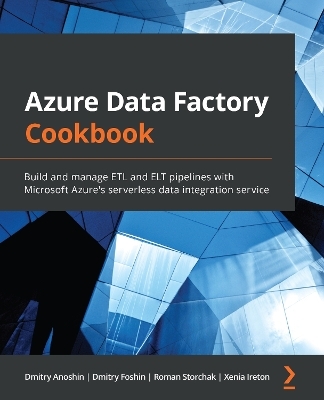
Azure Data Factory Cookbook
Packt Publishing Limited (Verlag)
978-1-80056-529-6 (ISBN)
Solve real-world data problems and create data-driven workflows for easy data movement and processing at scale with Azure Data Factory
Key Features
Learn how to load and transform data from various sources, both on-premises and on cloud
Use Azure Data Factory’s visual environment to build and manage hybrid ETL pipelines
Discover how to prepare, transform, process, and enrich data to generate key insights
Book DescriptionAzure Data Factory (ADF) is a modern data integration tool available on Microsoft Azure. This Azure Data Factory Cookbook helps you get up and running by showing you how to create and execute your first job in ADF. You’ll learn how to branch and chain activities, create custom activities, and schedule pipelines. This book will help you to discover the benefits of cloud data warehousing, Azure Synapse Analytics, and Azure Data Lake Gen2 Storage, which are frequently used for big data analytics. With practical recipes, you’ll learn how to actively engage with analytical tools from Azure Data Services and leverage your on-premise infrastructure with cloud-native tools to get relevant business insights. As you advance, you’ll be able to integrate the most commonly used Azure Services into ADF and understand how Azure services can be useful in designing ETL pipelines. The book will take you through the common errors that you may encounter while working with ADF and show you how to use the Azure portal to monitor pipelines. You’ll also understand error messages and resolve problems in connectors and data flows with the debugging capabilities of ADF.
By the end of this book, you’ll be able to use ADF as the main ETL and orchestration tool for your data warehouse or data platform projects.
What you will learn
Create an orchestration and transformation job in ADF
Develop, execute, and monitor data flows using Azure Synapse
Create big data pipelines using Azure Data Lake and ADF
Build a machine learning app with Apache Spark and ADF
Migrate on-premises SSIS jobs to ADF
Integrate ADF with commonly used Azure services such as Azure ML, Azure Logic Apps, and Azure Functions
Run big data compute jobs within HDInsight and Azure Databricks
Copy data from AWS S3 and Google Cloud Storage to Azure Storage using ADF's built-in connectors
Who this book is forThis book is for ETL developers, data warehouse and ETL architects, software professionals, and anyone who wants to learn about the common and not-so-common challenges faced while developing traditional and hybrid ETL solutions using Microsoft's Azure Data Factory. You’ll also find this book useful if you are looking for recipes to improve or enhance your existing ETL pipelines. Basic knowledge of data warehousing is expected.
Dmitry Anoshin is a data-centric technologist and a recognized expert in building and implementing big data and analytics solutions. He has a successful track record when it comes to implementing business and digital intelligence projects in numerous industries, including retail, finance, marketing, and e-commerce. Dmitry possesses in-depth knowledge of digital/business intelligence, ETL, data warehousing, and big data technologies. He has extensive experience in the data integration process and is proficient in using various data warehousing methodologies. Dmitry has constantly exceeded project expectations when he has worked in the financial, machine tool, and retail industries. He has completed a number of multinational full BI/DI solution life cycle implementation projects. With expertise in data modeling, Dmitry also has a background and business experience in multiple relation databases, OLAP systems, and NoSQL databases. He is also an active speaker at data conferences and helps people to adopt cloud analytics. Dmitry Foshin is a business intelligence team leader, whose main goals are delivering business insights to the management team through data engineering, analytics, and visualization. He has led and executed complex full-stack BI solutions (from ETL processes to building DWH and reporting) using Azure technologies, Data Lake, Data Factory, Data Bricks, MS Office 365, PowerBI, and Tableau. He has also successfully launched numerous data analytics projects – both on-premises and cloud – that help achieve corporate goals in international FMCG companies, banking, and manufacturing industries. Roman Storchak is a PhD, and is a chief data officer whose main interest lies in building data-driven cultures through making analytics easy. He has led teams that have built ETL-heavy products in AdTech and retail and often uses Azure Stack, PowerBI, and Data Factory. Xenia Ireton is a software engineer at Microsoft and has extensive knowledge in the field of data engineering, big data pipelines, data warehousing, and systems architecture.
Table of Contents
Getting Started with ADF
Orchestration and Control Flow
Setting up a Cloud Data Warehouse
Working with Azure Data Lake
Working with Big Data – HDInsight and Databricks
Integration with MS SSIS
Data Migration – Azure Data Factory and Other Cloud Services
Working with Azure Services Integration
Managing Deployment Processes with Azure DevOps
Monitoring and Troubleshooting Data Pipelines
| Erscheinungsdatum | 16.01.2021 |
|---|---|
| Verlagsort | Birmingham |
| Sprache | englisch |
| Maße | 75 x 93 mm |
| Themenwelt | Informatik ► Datenbanken ► Data Warehouse / Data Mining |
| Mathematik / Informatik ► Informatik ► Theorie / Studium | |
| ISBN-10 | 1-80056-529-1 / 1800565291 |
| ISBN-13 | 978-1-80056-529-6 / 9781800565296 |
| Zustand | Neuware |
| Haben Sie eine Frage zum Produkt? |
aus dem Bereich


